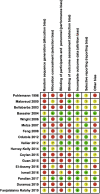Epidemiology and aetiology of male and female sexual dysfunctions related to pelvic ring injuries: a systematic review
- PMID: 34378143
- PMCID: PMC8514382
- DOI: 10.1007/s00264-021-05153-8
Epidemiology and aetiology of male and female sexual dysfunctions related to pelvic ring injuries: a systematic review
Abstract
Introduction: Pelvic ring injuries, frequently caused by high energy trauma, are associated with high rates of morbidity and mortality (5-33%), often due to significant blood loss and disruption of the lumbosacral plexus, genitourinary system, and gastrointestinal system. The aim of the present study is to perform a systematic literature review on male and female sexual dysfunctions related to traumatic lesions of the pelvic ring.
Methods: Scopus, Cochrane Library MEDLINE via PubMed, and Embase were searched using the keywords: "Pelvic fracture," "Pelvic Ring Fracture," "Pelvic Ring Trauma," "Pelvic Ring injury," "Sexual dysfunction," "Erectile dysfunction," "dyspareunia," and their MeSH terms in any possible combination. The following questions were formulated according to the PICO (population (P), intervention (I), comparison (C), and outcome (O)) scheme: Do patients suffering from pelvic fracture (P) report worse clinical outcomes (C), in terms of sexual function (O), when urological injury occurs (I)? Is the sexual function (O) influenced by the type of fracture (I)?
Results: After screening 268 articles by title and abstract, 77 were considered eligible for the full-text analysis. Finally 17 studies that met inclusion criteria were included in the review. Overall, 1364 patients (902 males and 462 females, M/F ratio: 1.9) suffering from pelvic fractures were collected.
Discussion: Pelvic fractures represent challenging entities, often concomitant with systemic injuries and subsequent morbidity. Anatomical consideration, etiology, correlation between sexual dysfunction and genitourinary lesions, or pelvic fracture type were investigated.
Conclusion: There are evidences in the literature that the gravity and frequency of SD are related with the pelvic ring fracture type. In fact, patients with APC, VS (according Young-Burgess), or C (according Tile) fracture pattern reported higher incidence and gravity of SD. Only a week association could be found between GUI and incidence and gravity of SD, and relationship between surgical treatment and SD. Electrophysiological tests should be routinely used in patient suffering from SD after pelvic ring injuries.
Keywords: Dyspareunia; Lumbosacral plexus; Pelvic ring injuries; Penile erection; Sexual disfunction.
© 2021. The Author(s).
Conflict of interest statement
The authors declare no competing interests.
Figures


References
-
- Figler BD, Hoffler CE, Reisman W, et al. (2012) Multi-disciplinary update on pelvic fracture associated bladder and urethral injuries 44:1967. 10.1016/j.injury.2012.03.031 - PubMed
Publication types
MeSH terms
LinkOut - more resources
Full Text Sources
Medical
Miscellaneous

